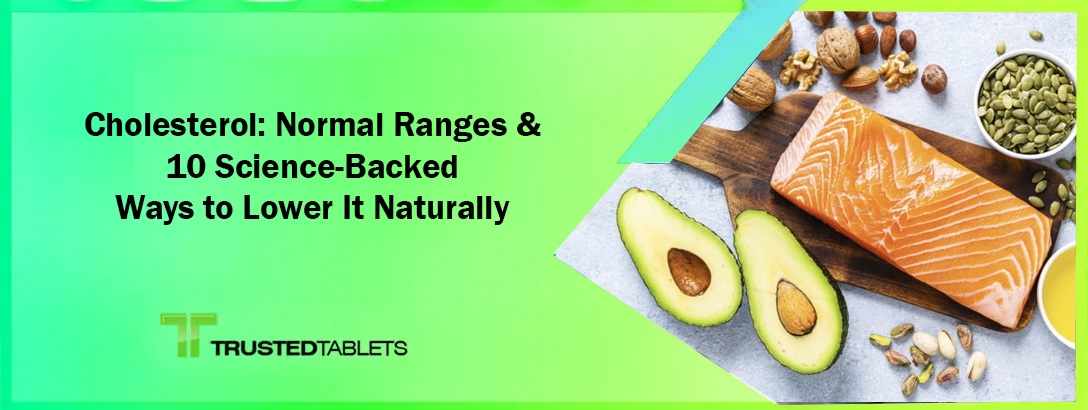Introduction: Decoding Your Cholesterol Numbers
Cholesterol isn’t inherently bad—it’s vital for hormone production and cell health. But high LDL (“bad”) cholesterol doubles your risk of heart attack and stroke (American Heart Association). While medications exist, research shows lifestyle changes can lower LDL by 20-30% without drugs. This guide breaks down cholesterol norms and 10 evidence-based natural strategies.
⚠️ Medical Disclaimer: Always consult your doctor before changing your health regimen. This article supplements—not replaces—professional medical advice.
What Is Cholesterol? The Good, Bad & Triglycerides
Cholesterol travels through blood on lipoproteins:
- LDL (Low-Density Lipoprotein): “Bad” cholesterol. Builds plaque in arteries.
- HDL (High-Density Lipoprotein): “Good” cholesterol. Removes excess LDL.
- Triglycerides: Fat storing excess calories. High levels = heart disease risk.
Cholesterol Norms: Optimal Ranges by Age & Gender
Table based on NIH and American Heart Association guidelines:
| Component | Optimal (mg/dL) | Borderline (mg/dL) | High (mg/dL) |
|---|---|---|---|
| Total Cholesterol | <200 | 200-239 | ≥240 |
| LDL (“Bad”) | <100 | 100-129 | 130-159 |
| HDL (“Good”) | ≥60 | 40-59 (M) / 50-59 (F) | <40 (M) / <50 (F) |
| Triglycerides | <150 | 150-199 | ≥200 |
Note: Targets may vary for diabetics or those with heart disease.
10 Science-Backed Ways to Lower Cholesterol Naturally
1. Swap Saturated Fats for Unsaturated Fats
The Science: Replacing saturated fats (red meat, butter) with monounsaturated/polyunsaturated fats lowers LDL by up to 10% (Journal of the American Heart Association).
Actionable Tip:
- Use olive oil instead of butter.
- Snack on almonds, walnuts, or avocados (1 oz daily).
- Eat fatty fish (salmon, mackerel) 2x/week for omega-3s.
Source: AHA Scientific Statement
2. Embrace Soluble Fiber (Your Cholesterol Sponge)
The Science: Soluble fiber binds to cholesterol in the gut, removing it before absorption. 5-10g daily can lower LDL by 5% (NIH).
Actionable Tip:
- Start your day with oatmeal (4g fiber/serving).
- Add beans to salads (1 cup = 15g fiber).
- Snack on apples, pears, or chia seeds.
Source: National Institutes of Health (NIH)
3. Exercise Aerobically 5x/Week
The Science: Aerobic exercise raises HDL (“good” cholesterol) by 5-10% and lowers LDL/triglycerides (Circulation Journal).
Actionable Tip:
- Aim for 150 minutes/week of brisk walking, cycling, or swimming.
- Add resistance training 2x/week for extra benefits.
Source: American College of Cardiology
4. Lose Excess Weight (Even 5-10% Helps)
The Science: Weight loss reduces LDL and triglycerides while boosting HDL. Losing 10 lbs can lower LDL by 8% (Mayo Clinic).
Actionable Tip:
- Track calories with apps like MyFitnessPal.
- Focus on portion control (use smaller plates).
Source: Mayo Clinic Proceedings
5. Quit Smoking (HDL Boost in 8 Weeks)
The Science: Smoking lowers HDL and damages blood vessels. Quitting raises HDL by 30% within 3 months (AHA).
Actionable Tip:
- Use nicotine replacement therapy or apps like Smoke Free.
- Avoid secondhand smoke.
Source: American Heart Association
6. Limit Alcohol (or Avoid Entirely)
The Science: Excessive alcohol raises triglycerides and blood pressure. Moderate drinking = ≤1 drink/day for women, ≤2 for men.
Actionable Tip:
- Swap cocktails for mocktails.
- Have “alcohol-free” days weekly.
Source: CDC
7. Add Plant Sterols/Stanols
The Science: These compounds block cholesterol absorption. 2g daily can lower LDL by 10% (European Food Safety Authority).
Actionable Tip:
- Choose fortified margarines (e.g., Benecol), yogurts, or orange juice.
- Eat small amounts daily for consistency.
Source: Journal of Nutrition
8. Reduce Sugar & Refined Carbs
The Science: High sugar intake raises triglycerides and LDL while lowering HDL (Journal of the American College of Cardiology).
Actionable Tip:
- Replace soda with sparkling water + lemon.
- Swap white bread/pasta for whole grains.
Source: AHA
9. Manage Stress (Cortisol = Cholesterol Enemy)
The Science: Chronic stress triggers cortisol release, increasing cholesterol production (Journal of Psychiatric Research).
Actionable Tip:
- Practice 10 minutes of daily mindfulness (apps: Calm, Headspace).
- Try yoga or deep breathing exercises.
Source: American Psychological Association
10. Prioritize Sleep (7-9 Hours/Night)
The Science: Poor sleep raises LDL and triglycerides (Sleep Medicine Reviews).
Actionable Tip:
- Maintain a consistent sleep schedule (even weekends).
- Keep your bedroom dark, cool, and screen-free.
Source: National Sleep Foundation
When to See a Doctor
Lifestyle changes work best for mildly elevated cholesterol. Consult your doctor if:
- Your LDL is ≥190 mg/dL.
- You have diabetes, heart disease, or family history of early heart attacks.
- Natural strategies don’t improve levels after 3-6 months.
Conclusion: Small Changes, Big Impact
Lowering cholesterol without medication is about consistent, evidence-based habits—not perfection. Start with 2-3 strategies from this list (e.g., swapping butter for olive oil + daily walks). Track progress with blood tests every 4-6 months. Your heart will thank you!
Your Turn: What’s one cholesterol-lowering habit you’ll try today? Share below! 👇


